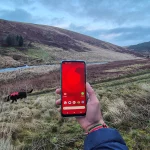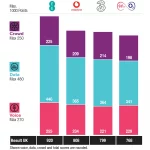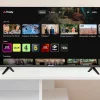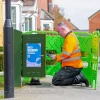Football Streaming Pushes BT to Record UK Broadband Traffic of 33.7Tbps

Broadband and telecoms giant BT (EE) has used a mix of UK network stats and a consumer survey of 2,000 adults to reveal how the “British public are engaging with the biggest cultural moments of the year“. BT also hit a record peak of broadband traffic on 4th Dec 2024, when streaming of Premier League Football helped push them to 33.7Tbps (Terabits per second).
According to the operator’s new ‘2024 Network Wrapped‘ research, some 56% of people in the UK believe live sport provided the “most significant cultural moments of the year“, deeming it “more important” than the UK general election (55%), live music (29%), film and TV releases (15%) and gaming launches (11%).
BT’s research also found that 58% of Gen Z (i.e. people born in the late 1990s and early 2000s) have now taken up split-screening during major events, using second screens to multi-task online and stay connected to group chats and loved one (falling to 35% for all respondents). Meanwhile, 1 in 16 people admit to having secretly streamed live events on their phone while attending a wedding, funeral, or christening.
Advertisement
Key Highlights from the Study
➤ The top reasons Brits are using secondary screens during major events include scrolling social media (47%), messaging friends and family (39%), shopping online (33%) and playing video games (30%).
➤ This year has also seen a greater rise in ‘secret streaming’ with 46% of multi-tasking men having been caught watching a live event covertly.
➤ Some 27% of Millennials (i.e. people born between the early 1980s and the mid-1990s) now livestream their attendance at major events to share the experience with others, while 35% of Gen Z attendees admit to video calling friends or family members from an event venue.
➤ 61% spend up to 2 hours preparing to attend live events, with 14% of ultra-organised Brits spending more than 3 hours researching travel routes, setting up group chats, buying new outfits online, and chatting to fellow event goers on social media. This suggests Brits often spend more time planning to attend an event than the duration of the event itself; none more so than those in the East Midlands, where people spend the most time preparing to attend a live event – an average of 2 hours and 4 minutes.
➤ People spent more than £155 on average, in addition to their ticket, to attend major events in 2024, while 1 in 10 admit they to spending an additional £300 per event. Fans in the Northeast of England are some of the most likely to spend on additional experiences such as VIP access and merchandise, splashing out 66% more than those in Norfolk and Suffolk, who spend the least on average (£114.38 vs £68.51).
➤ The biggest frustrations with attending the UK’s biggest cultural moments include queuing to get into the venue, for the toilets, or for food and drink (47%), managing parking and travel (27%), trying to find the right seats (15%), and people recording entire shows on their phones (13%).
➤ 24% of Brits are planning to attend or engage with even more major events in 2025.
➤ Over the next five years, mobile broadband (data) usage is forecast to grow between 15% and 28% as venues, event organisers and consumers take advantage of improved connectivity provided by 5G Standalone technology to deliver better live experiences.
Howard Watson, BT’s Chief Security and Networks Officer, said: “This year has seen the British public connect, stream, and split-screen their way through some truly iconic moments – from the final of Euro 2024 to Taylor Swift’s record-breaking Eras Tour. But with more people using more connected devices than ever before, there is a growing desire – among all generations – to be part of the biggest cultural moments as they happen, and this is reshaping how we all use connectivity.”
Mark is a professional technology writer, IT consultant and computer engineer from Dorset (England), he also founded ISPreview in 1999 and enjoys analysing the latest telecoms and broadband developments. Find me on X (Twitter), Mastodon, Facebook, BlueSky, Threads.net and Linkedin.
« Voneus Face Rural Broadband Complaints in Shropshire and Powys























































I expect we will have soon reached the tipping point where the majority of TV viewing is done via streaming instead of DTV and DBS. I think we are probably done so already.
I don’t think it is there yet, I think the majority of people still watch linier TV for the most part, only using online for streaming service like Netflix and maybe catch up. The majority of people I know, well the older ones, still watch linier TV, either via Terrestrial or Satellite. It will come at some point, certainly if Freely catches on.
Myself, I stream 99% or more of the stuff I watch, I don’t have a TV licence, the other 1% is via DVD/Blueray.
It is certainly the younger ones who don’t bother with normal TV and as the older people die off, linier TV will cease to be
Across video content in terms of watch time it’s about 60:40 in favour of streaming over *linear* TV with the predictable division according to age.
Hard to get full numbers on the split on *linear* between broadcast and online but TVs preferring online over DTV/DBS when they’ve both available will swing the balance immediately and can be done with software.
Good news that the networks are more than capable of dealing with this, now let’s work on getting the latency on live events below 10s.
Be careful now a whole 10 seconds.
Don’t forget that satellite and terrestrial digital TV have a latency.
Not so much these days, but in the past, while outside, I have heard people cheering a couple of seconds after others have cheered in houses. so I presume one lot is watching via Freeview and another via Dsat. If you are watching on Tv and getting commentary on radio, that will never line up these days.
Sky Stream/Glass’s Low Latency update has got it down to around 8 seconds. I think Dsat is around the 10-15 second mark, so that’s pretty damn good for delivery via the internet instead of via dsat.
It’s impressive that the networks can handle this, and yet at the same time it seems like insanity. We built highly efficient broadcast TV networks that can deliver this content much more effectively, but we’re abandoning them and using data networks instead.
@mike: The days are long gone when a network handled just one type of traffic, e.g. PSTN was for phones, cable network was for TV. Now these networks handle broadband as well. As for BT/EE: I’m sure that most of the reported heavy football streaming was over the Openreach network to EE TV’s Box Pro which supports UHD and HDR.
It’s probably more efficient to broadcast over IP than to hold back what broadcasters can do until the next version of a DVB spec makes its way into TVs. When everything is delivered over IP then there’s nothing stopping a broadcaster from providing whatever resolution, framerate and bitrate they decide, with whatever audio they want to use. The current system requires lots of energy to be consumed broadcasting SD channels on DVB-T eating up loads of bandwidth to suit the lowest common denominator, when a shift to IP could remove the need for SD streams entirely and have the end client handle downscaling if required.
I don’t know that it is all that efficient now. It uses a huge swathe of the band to deliver service to an ever declining group of people. It’s more efficient to treat it as just another type of traffic on a general purpose IP network.
I think the problem with what we now consider legacy systems is control for the content providers. Notice how streaming boxes dont offer recording facilities as an example.
Most of the large ISPs have a multitude of CDN boxes ‘deep’ within their network. E.g. if there’s a core point of presence in any major city, there might be over 100gbit of Netflix, Cloudfront, and Akamai (etc) capacity there, too, from dedicated cache servers.
It means that a Netflix viewer in Stoke might be served content out of Manchester, completely separately to someone watching in Plymouth who’s being served the same content from a server in Exeter. This uses no bandwidth at all at the ISP’s main peering/transit points, so they’re free to do whatever else is happening online (that video call between someone in Ipswich and their family in Sri Lanka, for example)
This 33.7 Tbps is related only to BT Retail or is the total traffic of Open Reach broadband access network?
BT only.